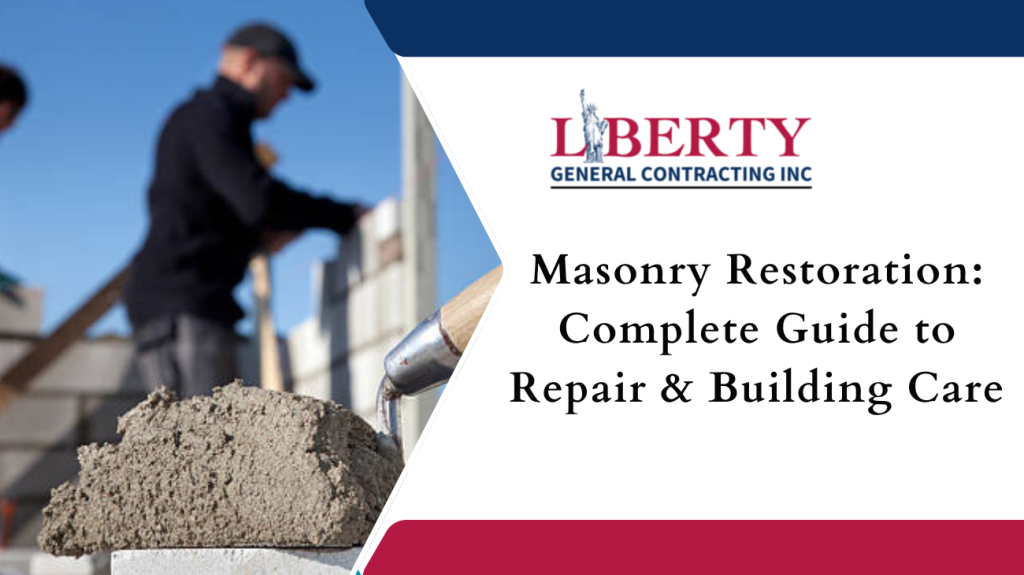Masonry restoration is the work we do to repair and protect brick, stone, or block walls so buildings stay strong and look good. Old or damaged masonry can lead to leaks, crumbling walls, and safety problems. In this guide I’ll explain, in simple words, what masonry restoration is, why it matters, common problems, step-by-step repair methods, cost drivers, and how to choose the right contractor. I’ll keep it friendly and practical so you can understand every point and make smart decisions.
What is masonry restoration?
Masonry restoration means fixing and preserving masonry surfaces — bricks, natural stone, concrete blocks, and mortar joints. The goal is to stop further damage, restore structural strength, and keep the original look when possible. Restoration focuses on repair and conservation, not just replacement. Think of it as giving the building a careful health check and treatment.
Why masonry restoration matters
- Safety: Cracked or loose masonry can fall or let water in, causing bigger problems.
- Longevity: Proper restoration extends the life of the structure for decades.
- Appearance: Restoring masonry improves curb appeal and keeps the building looking cared for.
- Value: A well-maintained facade protects property value and reduces future costs.
- Heritage: For old or historic buildings, restoration preserves original materials and character.
When I look at a neglected wall, I think of it like skin that needs proper care — not just paint but real repair.

Common masonry problems (and what they mean)
Knowing the problem helps choose the right fix. Here are the usual issues:
- Cracks: Small hairline cracks may be cosmetic, but large or widening cracks can mean structural movement.
- Spalling: Flaking or chipping of brick or stone caused by freeze-thaw cycles or salt. It makes the surface powdery or hollow.
- Efflorescence: White powdery salt deposits on the surface — a sign of water moving through the masonry.
- Mortar deterioration: Old mortar can crumble or fall out, leaving gaps between masonry units.
- Staining and biological growth: Dirt, rust stains, algae, or moss can damage appearance and trap moisture.
- Bulging or bowing walls: Serious — may indicate water damage, failed ties, or foundation movement.
Each problem needs a different approach. I always recommend a careful inspection before deciding what to do.
First step: inspection and assessment
A proper masonry restoration starts with a detailed inspection:
- Visual check: Look for cracks, missing mortar, loose pieces, and stains.
- Tap test: Tapping bricks or stones can reveal hollow areas where the face has separated.
- Moisture check: Find where water is entering — windows, parapets, flashing, or gutters.
- Structural review: For big cracks or bulges, a structural engineer may be needed.
- Material sampling (for historic buildings): Test mortar and masonry to match materials.
This assessment tells you which repairs are urgent, what can be repaired and what must be replaced, and helps make a budget.
Key masonry restoration techniques
1. Repointing (renewing mortar joints)
Repointing means removing old, damaged mortar between bricks or stones and filling the joints with new mortar. It’s one of the most common fixes.
- Why: Old mortar crumbles and lets water in.
- How: Remove bad mortar carefully, clean the joint, and apply new mortar that matches color and strength.
- Tip: Using the wrong mortar mix can damage bricks — always match the original strength and composition.
2. Brick and stone replacement
When units are too damaged, they are carefully removed and replaced with matching bricks or stones.
- Why: Spalled or broken units weaken the wall.
- How: Salvage matching units or source similar new ones, set them with proper mortar, and finish to match appearance.
3. Cleaning
Cleaning removes stains, biological growth, and grime, but must be done gently.
- Methods: Low-pressure washing, chemical cleaners designed for masonry, or gentle abrasive methods for heavy deposits.
- Caution: High-pressure washing or harsh chemicals can strip surfaces or push water into the wall.
4. Crack repair and stitching
Small cracks can be filled with compatible mortars or sealants. For structural cracks, “stitching” uses stainless steel bars across the crack to tie the wall back together.
- Why: Prevent cracks from widening and restore strength.
- How: Insert bars across the crack and grout them in, then finish to match the surface.
5. Consolidation and injection
For hollow or delaminated masonry layers, consolidants or grout injections can re-bond the material.
- Why: Save original material instead of replacing it.
- How: Inject special grout or epoxy into voids to fill and strengthen.
6. Waterproofing and flashing repairs
Fixing sources of water entry is essential: repair flashing, gutters, downspouts, and apply breathable water repellents where appropriate.
- Why: Stop the root cause of many masonry failures — moisture.
- How: Replace damaged flashing, improve drainage, and apply breathable coatings that keep water out but allow trapped moisture to escape.
Materials and mortar — why matching matters
Using the right mortar and materials is critical. Modern Portland cement mortars are strong but can be too hard for old, soft bricks and cause more damage. Lime-based mortars are often better for historic masonry because they are softer and more flexible. I always recommend testing and matching mortar composition, color, and texture for a long-lasting, authentic repair.
Cost factors for masonry restoration
Restoration costs vary by damage extent, building size, materials, and labor skill. Main cost drivers:
- Severity of damage — small repointing jobs are cheaper than full rebuilds.
- Height and access — tall walls need scaffolding or lifts, which raises cost.
- Material matching — sourcing old-style bricks or stone can cost more.
- Labor skill — experienced stonemasons or conservators cost more but do better work.
- Hidden repairs — structural fixes or replacing rotten lintels add expense.
Get several quotes and ask contractors for itemized estimates. A cheap price now may mean more costs later if repairs are done wrong.
DIY vs professional work — what you should do yourself
Small cosmetic tasks — cleaning small stains, replacing a few loose bricks at ground level, or patching surface mortar — can be DIY if you are confident. But for anything structural, high up, or on a historic facade, hire a pro. Masonry restoration needs the right materials, tools, and experience; mistakes are costly and sometimes irreversible.
Choosing the right contractor
When hiring, check:
- Experience with masonry and restoration
- References and photos of past work
- Insurance and licenses
- Understanding of historic materials if your building is old
- Detailed written estimate and timeline
Talk with candidates about methods they plan to use — demand explanations in plain language so you understand the work.
Maintenance after restoration
Restoration is not a one-time fix — do small checks every year:
- Re-point small gaps quickly.
- Keep gutters and flashing clear.
- Remove plants or vines that can hold moisture.
- Clean gently when needed.
- Repair small cracks early.
A little yearly care keeps repair bills low and extends life.
Environmental and heritage considerations
For historic buildings, use conservation best practice: repair rather than replace, use matching materials, and consult local preservation rules. Environmentally, use breathable treatments and avoid harmful chemicals that lock moisture in or damage masonry.
Conclusion
Masonry restoration protects the structure, beauty, and value of a building. Start with a careful inspection, pick the right repair methods like repointing or selective replacement, match materials, and hire skilled contractors when needed. With proper restoration and regular care, masonry can last for generations.
Contact Liberty GCNY
Website: www.libertygcny.com
Phone: (347) 682-9840
Serving: Manhattan, Brooklyn, Queens, The Bronx, Westchester County, and Long Island.
Address:110-14 178th St, Jamaica, NY
Need Help with Your Next Project? Call Liberty GCNY Today!
Fast responses. Expert advice. Trusted service across NYC and beyond.


